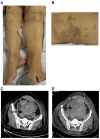Case Report: Life-Threatening Post-operative Hemorrhage in Klippel-Trenaunay Syndrome Associated With Hypofibrinogenemia
- PMID: 34434940
- PMCID: PMC8380826
- DOI: 10.3389/fmed.2021.669793
Case Report: Life-Threatening Post-operative Hemorrhage in Klippel-Trenaunay Syndrome Associated With Hypofibrinogenemia
Abstract
Klippel-Trenaunay Syndrome (KTS) is a rare congenital disorder, characterized by venous and lymphatic malformations of the skin, soft tissue, and bone, causing limb hypertrophy. Although, a ruptured hemorrhagic corpus luteum is a rare condition in women of reproductive age, it can result in lethal outcomes. Here, we have described a patient with KTS and hypofibrinogenemia who went through recurrent lethal postoperative bleeding due to a ruptured hemorrhagic corpus luteum. This case suggested that conservative therapy might be the first choice and effective therapy for the patients with KTS, who suffered from bleeding complications of surgical therapy.
Keywords: conservative therapy; fibrinogen concentrate; hypofibrinogenemia; klipple-trenaunay syndrome; post-operative hemorrhage; prophylactic transfusion of fibrinogen.
Copyright © 2021 Yang, Du, Liu, Yao and Li.
Conflict of interest statement
The authors declare that the research was conducted in the absence of any commercial or financial relationships that could be construed as a potential conflict of interest.
Figures

References
-
- Oduber CE, van Beers EJ, Bresser P, van der Horst CM, Meijers JC, Gerdes VE. Venous thromboembolism and prothrombotic parameters in Klippel-Trenaunay syndrome. Neth J Med. (2013) 71:246–52. - PubMed
Publication types
LinkOut - more resources
Full Text Sources

